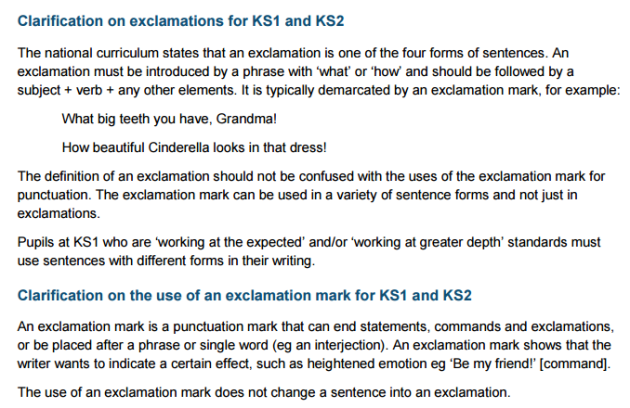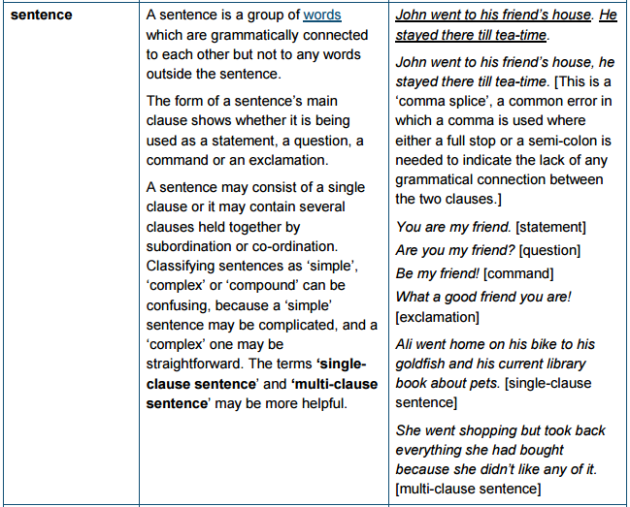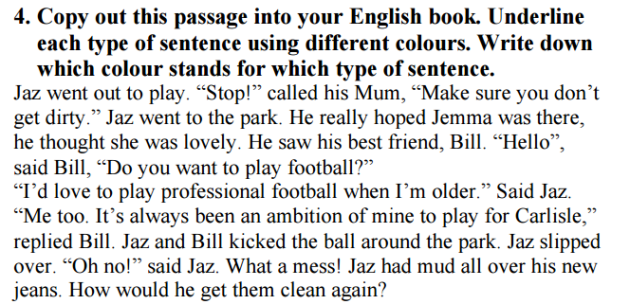Have I got precision for you!
March 11, 2016 6 Comments
I know I’ve got a bit of a reputation for pedantry, especially when it comes to DfE curriculum documents. I promise you, I don’t scour them all looking for mistakes. That would be petty. But when they’re physics bloopers or causing a ruckus, then I like to look into things a bit more.
What follows isn’t a judgement on whether the DfE are right or wrong about exclamations, only that I think their instructions and definitions lack clarity and precision, and that this topic is likely to be very confusing for 10/11 year olds (and under).
Firstly, I fully accept that the exclamation debacle is not about whether students are only allowed to use exclamation marks after exclamations that begin with what or how. It is about the definition of an exclamation and in an attempt to calm the waters, the DfE have sent out this clarification:

Instructions in the clarification document
“The use of an exclamation mark does not change a sentence into an exclamation”. Of course it doesn’t! No one said it does (though some have had a joke about banning exclamation marks).
Let’s read the top line together shall we: The national curriculum states that an exclamation is one of the four forms of sentences.
Yes it does, here it is:

And the rest of the relevant detail (they discuss exclamation marks a lot too).

There’s the example: What a good friend you are! [exclamation]
So what’s the problem? Well, one example is rather vague isn’t it? And looking online for resources that schools use throws up some anomalies. Let’s ignore English schools using American English resources (a troublesome situation perhaps).
Here’s the second resource in a google search for sentence types exclamation
http://www.primaryresources.co.uk/english/pdfs/sentence2.pdf
And a task from it:

How do we know which are the exclamations?
In a SPAG test the only correct answer is What a mess! [EDIT more on this later]
But depending on your definition then Stop! and Oh no! might be classed as exclamations:
an abrupt, emphatic, or excited cry or utterance; interjection; ejaculation
http://www.collinsdictionary.com/dictionary/english/exclamation
An exclamation (also called an interjection) is a word or phrase that expresses strong emotion, such as surprise, pleasure, or anger. Exclamations often stand on their own, and in writing they are usually followed by an exclamation mark rather than a full stop:
How wonderful!
Ow! That hurt!
Exclamations are also used to express greetings or congratulations:
Hello!
Well done, lads!
http://www.oxforddictionaries.com/words/exclamations
The DfE don’t really mean exclamation when they say exclamation. They mean exclamation clause.
The only clear definition I’ve found about exclamation clauses comes from English Grammar Today via the Cambridge dictionary website:
We use exclamations to express surprise or shock or a strong emotion about something. The type of phrase or clause associated with exclamations is called exclamative.
We usually form exclamatives with what or how. In writing, we usually put an exclamation mark (!) at the end of the exclamative:
What an amazing car!
How I love the summer holidays!
http://dictionary.cambridge.org/grammar/british-grammar/exclamations
The suggestion here is that there are different forms of exclamations with certain exclamation clauses (exclamatives). But they don’t just include what and how forms as shown further down on that page.
There are interrogative exclamatives that appear like questions but aren’t: Have I got news for you! which is functionally the same as I’ve got news for you! but the I and the have are inverted. It’s not a question, you wouldn’t answer yes or no (it’s not even a rhetorical one). It’s an exclamatory statement (and a commonly used one at that).
So here’s the thing: the document that test developers are to use is very specific about what is and isn’t allowed for the test.

Instructions to SPAG test developers.
Those weasel words are such a problem (for me as a parent): For the purposes of the test.
Everywhere there are resources children are using to learn to read and write from. And there are exclamations throughout them. I’ve just been through my daughter’s reading books. They’re everywhere. Some are interjections, some are what or how sentences. Some are imperative.
It’s confusing, and as my series of tweets from earlier this evening suggested – the DfE would have done well to define exclamation separately from an exclamative clause which is what they’re testing in the SPAG test.
Have I got pedantry for you! If only the DfE had used the term exclamative as the clause to begin with what or how. https://t.co/bH3X590g2n
— Alex Weatherall (@A_Weatherall) March 11, 2016
(there are more below that one)
Anyway I leave you with an exclamation; how would you categorise it?
“Boy, do I hate being right all the time!”
Dr. Malcolm in Jurassic Park
*Thanks @DiLeed for the retitle.
EDIT – Martin Galway has added a further twist in the comments below – I will summarise here:
I spotted something as I went to sleep last night, that was still bothering me this morning, and then Martin wrote to me on twitter asking if I minded him adding a comment – I said of course. What a comment [he wrote]!
You see, the clarification document at the top of the page in trying to make things better, adds another constraint:

Wait a minute!
Let’s recap the new rules (from Martin’s comment below). Perhaps a check list would help the students:
- Phrase begins with What / How?
- Does not take the form of a question?
- Subject + verb?
- Exclamation mark?
OK so lets look at the examples we’ve got [as pointed out by Martin]:
What a mess! (from the online teacher resource I found – and I thought passed the SPAG test)
This passes 1,2 and 4 but not 3 which was added in the clarification document! <- 10 points from Gryffindor.
What a lovely day! (example from the Test Specification document from the DfE!)
This passes 1,2 and 4 as well. Their own example doesn’t pass the requirements in the clarification document! <- 50 points from Slytherin 😉
How exciting! (2nd example from the Test Specification document from the DfE!)
This passes 1, 2, and 4 – but this has neither a subject nor a verb. Again the example they have given the test developments doesn’t pass the requirements in the clarification document! <- 200 points from Slytherin
Boy, do I hate being right all the time!
This doesn’t pass 1 or 2, but it has a subject, a verb and an exclamation mark 🙂 <-20 points from Gryffindor
So let me spell this out for you: the examples for the test developers contradict the clarification document!
From Martin below:
The fact that the frameworks continue to linger online with examples that are not creditworthy strengthens your point. Contradictory materials have led to confusion, and have led to all sorts of inference going on – some inferefences complete/some not. For my part, until the writing exemplars came out, my colleagues and I thought this would only appear in the test. The framework said:”For the puprose of the test.” So it seemed a reasonable deduction. Now that it is required in teacher assessment of writing for KS1, somehow these constructions will need to appear in the range of evidence.
What a total and utter stupid mess [this is]! <- 100 points to Gryffindor 🙂